Frank Herbert
 Frank Herbert is, of course, best known for creation of "Dune" (the "most selling science fiction novel of all time"), but he also wrote some of the most intelligent and sophisticated science fiction (mostly in the 1960s-1970s), exploring many issues of spirituality, psychology, ecology - while managing to entertain readers at the same time. ---------------------------------------------- "A-W-F, Unlimited" © Galaxy, Jun 1961 The Worlds of Frank Herbert, 1970 --/ cool sf story ---------------------------------------------- 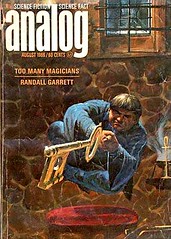 "By The Book" © Analog, Aug 1966 Eye, 1985 ---------------------------------------------- "Cease Fire" © Astounding, Jan 1958 Eye, 1985 "Death Of A City" © Future City, ed. R. Elwood, 1973 Eye, 1985 ---------------------------------------------- 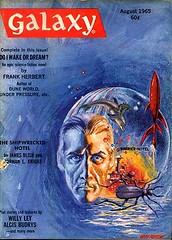 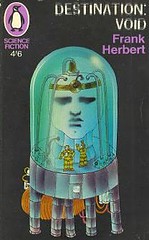 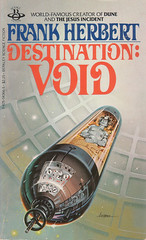 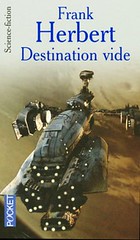 "Destination: Void" (nv) (also as "Do I Wake Or Dream?") (Voidship Earthling series) © Galaxy, Aug 1965 book: Berkley /Putnam, 1966 --/ third place sf novel --/ style award --/ idea award This is one of these Frank Herbert novels where a simple summary of the plot just won't do. It's a layered cake of ideas and a scientific extrapolation on a genius level. This Wikipedia article does a pretty good job in filling us in on the plot: "In the future, humankind has tried to develop artificial intelligence, succeeding only once, and then disastrously. The project has been moved to the moon, where the scientists have cloned themselves. These clones are kept isolated and raised to believe that they are the crew of a spaceship that will colonize another planet. The spaceship will be multi-generational, needing only a crew of six, and carrying thousands of other clones in hibernation. The clone crew is really just a caretaker: the ship is controlled by the disembodied human brains (known by the euphemism "Organic Mental Cores") that run the complex operations of the vessel and keep it moving in space. But the brain dies, and when the backup is awakened, it dies as well. After the second backup fails, the crew is faced with a choice: turn around, or build the computer systems that will enable the ship to continue. Their orders from the moon base are to continue at all costs; if they turn back, they will be destroyed. As the crew deals with their situation, they come to understand the dilemma they’re in: build an artificial intelligence to carry on the mission, or die" Deeply psychological and strangely fragile environment, in which scientists operate in this book, makes this book endlessly fascinating to read. Brilliance is forced to appear out of necessity, and scientific breakthroughs emerge out of sheer fear and intimidation. You could've called this novel "Under Pressure", if Herbert would've not used such title already. As it happens, this writer is best in psychological power games, and revels in "geniuses in distress" situations. The novel will tax you and strain you (some discussions may get too prolonged and obtuse), but it will also entertain. Mind-blowing dialog discusses the nature of consciousness while the action unfolds at a lively pace. Keeping in mind the year of publication, the discussion about computers is still fresh and compelling. There is also the notion of faked journey and staged conspiracy, which sheds a pall over the whole narrative, like a haunted deep note, sounding in a solemn halls of doomed intelligence. review: 10-Jul-07 (read in 1998) ---------------------------------------------- "Do I Sleep Or Wake?" (also as "The Eyes Of Heisenberg") © Galaxy, Mar 1965 book: Putnam, 1966 --/ cool sf novella "The Dosadi Experiment" (nv) (Whipping Star 2) © Galaxy, May 1977 book: Berkley, 1970 --sf novel : 1978 Locus /7 --/ cool sf novel ---------------------------------------------- "The Dragon in the Sea" (nv) (also as "Under Pressure" - see) (also as "21st Century Sub") © Astounding, Nov 1955 book: Avon Books, 1956 ----------------------------------------------   "Dune" (nv) (also as "Dune World") (Dune series #1) © Analog, Dec 1963 - Feb 1964 Berkley Medallion / Ace / Chilton, 1965 --novel : 1966 Hugo W (tie) --novel : 1966 Nebula W --book : 1966 Astounding/Analog All-Time Poll /21 --foreign novel : 1974 Seiun Award W --all-time novel : 1975 Locus All-Time Poll W --all-time sf novel : 1987 Locus All-Time Poll W --sf novel (before 1990) : 1998 Locus All-Time Poll W --/ third place sf novel --/ wonder award --/ adventure award --/ style award Without a doubt, "Dune" is a legend – as is Frank Herbert, its author. The book, and Herbert, have won reams of awards; and there’s the "Dune" movie, the "Dune" mini-series, the "Dune" games, the "Dune" sequel … and the sequel, sequel, sequel (five in all). It’s considered by many to be the most successful science fiction work to date. Here’s the thing, though: is "Dune" really (or, "simply") science fiction? Now don’t get me wrong, "Dune" is a fantastic, incredible novel: wildly imaginative, brilliantly plotted, amazingly told and totally original. It also certainly has many speculative details: a far-far-future setting, an alien world, genetic memory, and so forth. But if you strip away a good percentage of those speculative ideas, what remains could very easily be merely an excellent novel. The story of "Dune" really has less to do with the SF details and more with Herbert’s skill as a storyteller. "Dune" is a carefully crafted tale of politics and intrigue: the characters – from the Savior of Dune and the Fremen, Paul Atreides (aka Muad'Dib), to the Head of House Harkonnen, The Baron – are maneuvering and manipulating everything around them on a complex social chessboard. A great example of this is the famous banquet sequence where nothing is as it appears and every gesture and manner is a carefully planned strategic exercise. "Dune" is also often called an early ‘ecological’ novel, meaning that Herbert addresses what’s now a pretty common theme: that nature is an essential – and very fragile – necessity. The Fremen are a perfect example of this: they live not on their desert world but with it, respecting its tremendous power as well as its precarious health. Again, if you take out the Sandworms and the Spice Melange they create "Dune" could still stand as a powerful statement about the need for man to also live with this plant and not just use it up and toss it away. There are many other elements in "Dune" that also could be taken away from the book’s far-future setting: the book’s exploration of Islamic culture (especially in relation to ecology), an examination of collapsing civilizations and decadence, and even a chance for Herbert to further look at the world through a Zen lens. In the end, it’s because Dune can stand without its science fiction elements that makes it such a great, and long-lasting, masterpiece. Herbert understood humans, even though he was setting their stage twenty-thousand years from today, and understood nature, even though "Dune" is on another world. With "Dune" he created a perfect allegory, one that speaks the truth of humanity, and nature, as clearly today as when it was written – and probably will for a very long time. Review by M. Christian  ---------------------------------------------- "Dune World" (nv) (part of "Dune") (Dune 1) © Analog, Dec 1963 book: Ace Books, 1965 --novel : 1964 Hugo --/ third place space sf novella --/ wonder award --/ adventure award --/ style award "Eye" (coll) © Berkley, 1985 --collection : 1986 Locus /19 "The Eyes Of Heisenberg" (nv) (also as "Do I Sleep Or Wake") © Galaxy, Mar 1965 book: Putnam, 1966 --/ cool sf novel "Frogs And Scientists" © Destinies, Aug 1979 Eye, 1985 "The God Makers" (nv) © 1972, Berkley / Putnam --/ fourth place sf novel --/ idea award --/ style award "The Gone Dogs" © 1954, Amazing Stories Amazing, June 1966 ----------------------------------------------  "The Green Brain" (nv) (also as "Greenslaves") © Amazing Stories, March 1965 Ace Books, 1965 Unfortunately, as with many other books by Frank Herbert, the fame and success of "Dune" has overshadowed "The Green Brain", making it another book only hardcore Herbert fans even know about. This is really unfortunate because while "The Green Brain" is not "Dune" it shares a common theme as well as revealing more of Herbert’s masterful skill as a storyteller. Herbert has often been called one of the first ‘ecological’ science fiction writers. True or not, his work definitely shows his concern about the health of the earth as well as man’s place in it. "Dune" explores that relationship, as does "Hellstrom’s Hive", and – especially – does "The Green Brain". Set in a comfortable familiar future, "The Green Brain" is about a society in open war with nature – the jungle to be exact. Needing room to expand, the world has cut, carved, burned, poisoned and smashed its way into the heart of the wilderness. The characters are, for the most part, soldier/exterminators fighting guerilla infestations of weeds, roots, seeds, animals and primarily insects, all the while pushing their native habits towards extinction. While "Dune" and "Hellstrom’s Hive" are more subtle about the ethical and moral issues surrounding man and his relationship to the environment, "The Green Brain" is deceptively simple: as man fights against nature, nature begins to evolve to terrifyingly fight back. ‘Deceptive’ because as with all of Herbert’s books even if the conflict is clear there are always other factors keep the story from becoming cartoonish. One of the best things about "The Green Brain" is clearly enunciated idea of nature and its evolving intelligence as alien yet familiar, like it’s a different side to the earth’s own mind – a different side that’s more than a little irked that humanity continues to be insanely stupid about not maintaining a respectful balance with it. Part of that anger, coupled with nature’s superb adaptability, comes out in the jungle’s new weapon: a collaborative hive of insects that expertly mimic what’s threatening them: humans. No, "The Green Brain" is not "Dune" but it’s still an excellent read and well worth picking up – as it everything else by Herbert. And, who knows, maybe you’ll start looking warily at insects... or people with very, very green eyes... Review by M. Christian ---------------------------------------------- "Greenslaves" (also as "The Green Brain") © Amazing Stories, Jan 1965 novel : Berkley, 1965 --/ cool sf novella "The Mary Celeste Move" © Analog, Oct 1964 The Best of Frank Herbert, 1975 --/ third place car sf story --/ idea: people lost in highways --/ wonder award --/ style award --/ emotion award --/ rare find "Mating Call" © Galaxy, Oct 1961 The Worlds Of Frank Herbert, 1971 "A Matter Of Traces" © Fantastic Universe, Nov 1958 Eye, 1985 "Murder Will In" (Afterlife Of Bailey - round-robin) © F&SF, May 1970 Eye, 1985 "Passage For Piano" © The Book Of Frank Herbert, 1973 Eye, 1985 "The Prophet of Dune" (nv) (part of "Dune") (Dune 1) © Analog, Jan 1965 book: Ace Books, 1965 --/ cool sf novel "The Rat Race" © Astounding, Jul 1955 Eye, 1985 ----------------------------------------------   "The Santaroga Barrier" (nv) © Amazing Stories, Oct 1967 Berkley Medallion, 1968 Something’s odd about Santaroga: sure, on the surface it might appear to be like any other community full of normal-looking people, but look a little closer – like psychologist Gilbert Dasein is hired to do – and Santaroga begins to look anything but average. For one thing, the town is far from accepting of anyone who isn’t a local. They aren’t hostile, at least not openly, but if you weren’t born in their valley they won’t buy from you, trade with you, or accept you in any way. It’s the Santaroga barrier, and what lies beyond it makes for a totally original and fantastic read. Everyone knows Herbert for his "Dune" books but what a lot of people, unfortunately, don’t know about this Grand Master of science fiction is that he’s written, in my mind at least, even better novels – and "The Santaroga Barrier" is one of them. It’s also unfortunate that some think science fiction has to have aliens, time travel, robots, and all those kinds of flashy, shiny, and far too-often grandiose concepts. What Herbert does in "The Santaroga Barrier" is show that science fiction can be based on a very simple idea, an idea that – when handled by a superb writer – can be more powerful and fascinating than anything flashy or shiny or grandiose. Without spoiling too much of the plot, Dr. Gilbert Dasein slams headfirst into the Santaroga Barrier, propelled to return to Santaroga by duty to his employers, his professional curiosity and by his own interests: a girl named Jenny who left him in Berkley, where she as a student and he a professor. One of the best elements of the story is a hauntingly slippery word that Dasein keeps hearing among the locals in relation to their lives and, especially, to their food: 'Jaspers'. It takes him some time but eventually Dasein gets to see through the barrier, at the societal wall the Santarogans have put up around their town. What he sees is what makes the book to entrancing: Jaspers is a ‘consciousness fuel’ additive the locals have been culturing and using for generations. What it does, though, is create a unity among the citizens: a form of collective will. But that’s not all: there’s something else beyond the barrier – a something else that’s killed everyone else who has tried investigating the town. Oh, sure, they might look like accidents but Dasein comes to realize that there’s nothing accidental about them, and if he doesn’t figure the puzzle out he might be next. Okay, that’s a teaser of the plot, but there’s something else about "The Santaroga Barrier" that keeps this book on my ‘favorites’ shelf: Herbert’s superb skill as a writer. There’s something almost hallucinatory about the style; it imparts a dreamlike air without resorting to overly flamboyant, pretentious language – a skill few do well and only writers like Herbert master. In the end, "The Santaroga Barrier" is a totally imaginative novel told with sparkling language and genius skill: the work of a master storyteller at the height of his game. Review by M. Christian ---------------------------------------------- "Seed Stock" © Analog, Apr 1970 Eye, 1985 "Soul Catcher" (nv) © 1972, Putnam "The Tactful Saboteur" (Whipping Star series) © Galaxy, Oct 1964 Eye, 1985 "Try To Remember!" © Amazing, Oct 1961 Eye, 1985 "21st Century Sub" (nv) (also as "Under Pressure" - see) (also as "The Dragon in the Sea") ----------------------------------------------   "Under Pressure" (nv) (also as "The Dragon in the Sea") (also as "21st Century Sub") © Astounding, Nov-Dec 1955, Jan 1956 book: Avon Books, 1956 --all time novel : 1975 Locus All-Time Poll /34 (tie) --/ third place sf novel --/ wonder award --/ adventure award --/ style award A murky, depressed, claustrophobic feeling permeates this book - one of the best submarine thrillers in the history of literature. The story of the troubled journey of a nuclear sub is deeply lodged in a web of conspiracies (and suspicions of conspiracies). It is full of psychological turmoil and undercurrents of emotion, and is written in a dense (but highly readable) style, keeping the reader enthralled till the very end. This is my favourite book by Frank Herbert, as he does not indulge himself in strange page-bloated discourses, but keeps the story flowing and the emotions intense. I especially adore "closed environment" stories with haunted characters who try to break the limits and conspiracies imposed upon them. The plot of this book is really quite simple: uncovering of a spy among the sub crew, stealing some oil from underwater pipelines, engaging enemy subs, and generally "heating up" the Cold War. But it is in the deep, deep mind currents that Herbert lays the ambiguous egg of paranoia and asks the reader to hatch it. (review by Avi Abrams) ---------------------------------------------- |
Click to go to "Dark Roasted Blend" site

|
Collecting Pulp Magazines Ephemera Interview with Avi Abrams |

|
Enchanting Victorian Fairy Tale Art "Then world behind and home ahead..." |

|
Exceptional British Scifi Artwork from the 1950s Space Pulp Art by Ron Turner and other British artists |

|
Pulp Pleasures: Eando Binder Great space adventure fiction from the 1930s "Where Eternity Ends" and other rare gems |
Also read recent posts:
Author's Pen Names - Most Complete List Ever
The Wonder Timeline: SF&F Restrospective
Space Adventure Article
|
"SF&F Reading Experience" is part of "Dark Roasted Blend / Thrilling Wonder" family of sites. We try to highlight the most entertaining and rewarding science fiction and fantasy, with emphasis on memorable reader experience, not necessarily general acceptance by the critics. Have fun, and delve into our extensive ratings and reviews! Most reviews are written by Avi Abrams, unless otherwise noted. Reviews also appear on our unique historical retrospective page Wonder Timeline of Science Fiction. Feel free to submit your own review, if a particular story is not listed here. All major OFFICIAL AWARDS are highlighted in BLUE ("winner" has a letter "W" by it, otherwise it is a runner-up only) Our PERSONAL AWARDS (ratings) are highlighted in RED and PURPLE: --/ first place : --/ second place : --/ third place : --/ fourth place : --/ cool : (equal to fifth place) ALL "BEST OF" LISTS ARE LOCATED HERE These awards are given in the following categories: - novel : - series : - novella : - story : - collection : Also, there are our personal STYLE / GENRE SPECIFIC AWARDS. These reflect the story's content and the lasting impression on the reader: --/ wonder award sense-of-wonder, "visual intensity" and inventiveness --/ idea award originality of idea / concept --/ adventure award exhilarating plot, excitement / action --/ style award outstanding literary qualities, inimitable style --/ romance award intense and beautiful love / relationships --/ humour award funny and cool --/ emotion award touching, lasting impression, sensitivity --/ shock value altogether wild --/ awesome scale mind-boggling; further enhances sense-of-wonder --/ rare find very hard to locate, mostly from old pulps, never reprinted, etc. Again, please feel free to leave your own review or comment under every writer's entry; also recommend us other stories you liked. |

1 Comments:
What about 'The Jesus Incident', my favourite Herbert book.
Post a Comment
<< Home